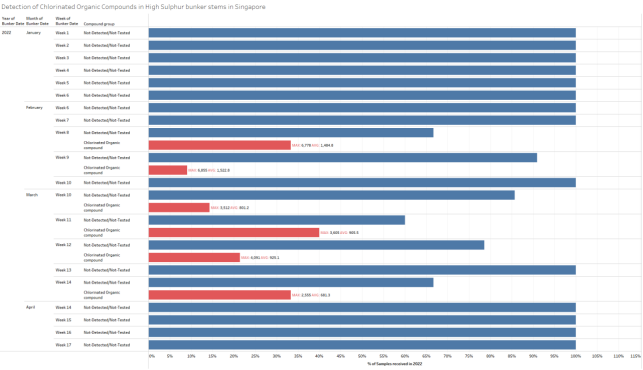Updates to detection levels and effects on machinery encountered
Since the last alert (
BF202203-02) dated 15-March-2022 on High Sulphur Bunker fuels contaminated with chlorinated organic compounds, CTI-Maritec has kept a close watch on the fuel quality in the region and collated further feedback on the fuel's usage. The summary data on samples from Q1 2022 shows the contaminants mainly have a detrimental effect on the fuel injection system and to a certain extent on the fuel treatment and filtration system.

The damages reported have affected both conventional and electronic engines and not limited to any Engine maker and type. This has led to failure of prime movers for the vessels affected by the contaminated fuel.

Our investigation thus far confirmed high concentration level with an average value of 3419ppm on 1,2-Dichloroethane (CAS no.107-06-2) as the main compound detected. This compound in its pure form is considered hazardous to personnel by OSHA causing irritation to eyes, respiratory system and skin depending on the exposure concertation and time. As with any marine fuel it is advised to ensure sufficient ventilation in the machinery spaces, particularly in the fuel treatment room. It is also advised to minimize personnel exposure to fuel tank vent heads as these chlorinated organic compounds have low boiling points that can be below the heating temperature of settling and service tanks.
It is difficult to determine a safe concentration level suitable for marine diesel engine usage or the baseline wherein machinery problems may occur. Due to the severity of the Machinery problems faced, we urge vessel operators to continue pre-emptively testing the fuels bunkered in the region by accredited test methods to detect these contaminants assessing the risk each bunker stem has on the vessel machinery.
It should be further noted that the compounds in question are not listed in the component table of the test method ASTM D7845-20 comprising of 29 commonly detected compounds and therefore can be missed by the quality control process in the supply side.
Maritec offers ASTM D7845-20 GCMS analysis & in addition extra 22 compounds calibrated with external standards for accurate quantification which includes organic chlorides.
The percentage of High Sulphur fuels detected with Chlorinated Organic Compounds by CTI-Maritec in Singapore bunker stems in 2022 is given below, a decreasing trend in the detection is observed for April 2022. Nevertheless, CTI-Maritec advises vessel owners to be vigilant and continue to pre-emptively test their fuel samples obtained from the receiving manifold.

Recommendation by CTI-Maritec:
1. Obtain quality assurance and test proof from suppliers on the absence of chlorinated organic compounds in the intended stem prior bunker delivery (This will require testing beyond the scope of standard ASTM D7845-20 test method)
2. Plan your bunkers well in advance to keep the incoming fuel segregated and reduce the risk of comingling.
3. Ensure sampling procedure during bunkering is witnessed by both supplier and receiver and sample bottles are counter-sealed and same recorded in the Bunker Delivery Note.
4. Pre-emptively test vessel manifold samples by accredited GCMS test methods capable of identifying the chlorinated organic compounds – preferably quantitative methods to identify the concertation levels of the detected compounds.
5. Pre-emptively conduct stability analysis outside the scope of ISO8217 involving the referee TSP method.
a. It is noted that the recent samples with the high levels of chlorinated organic compounds tested poorly for fuel stability when subject to Manual P-value by SMS1600 test method.
6. Be aware of your bunker supply contract and the notification time limit stipulated to flag potentially problematic fuels to the supplier.
7. Where chlorinated organic compounds have been detected, gather sufficient evidence to support further investigation. Proceed to conduct joint analysis in agreement with the supplier by an independent laboratory capable of detecting the compounds to determine the compliance with ISO8217 clause 5 – General Requirements.
This document however does not reflect on the overall quality of the fuel being supplied in Singapore. If you intend to bunker at this region, CTI-Maritec can assist you with further information of the bunker quality in the region.
The opinions expressed herein are the author's and not necessarily those of The Xinde Marine News.
Please Contact Us at:
media@xindemarine.com



 Ningbo Containerized Freight Index Weekly Commentar
Ningbo Containerized Freight Index Weekly Commentar  Ningbo Containerized Freight Index Weekly Commentar
Ningbo Containerized Freight Index Weekly Commentar  Ningbo Containerized Freight Index Weekly Commentar
Ningbo Containerized Freight Index Weekly Commentar  BIMCO Shipping Number of the Week: Bulker newbuildi
BIMCO Shipping Number of the Week: Bulker newbuildi  Ningbo Containerized Freight Index Weekly Commentar
Ningbo Containerized Freight Index Weekly Commentar  Ningbo Containerized Freight Index Weekly Commentar
Ningbo Containerized Freight Index Weekly Commentar